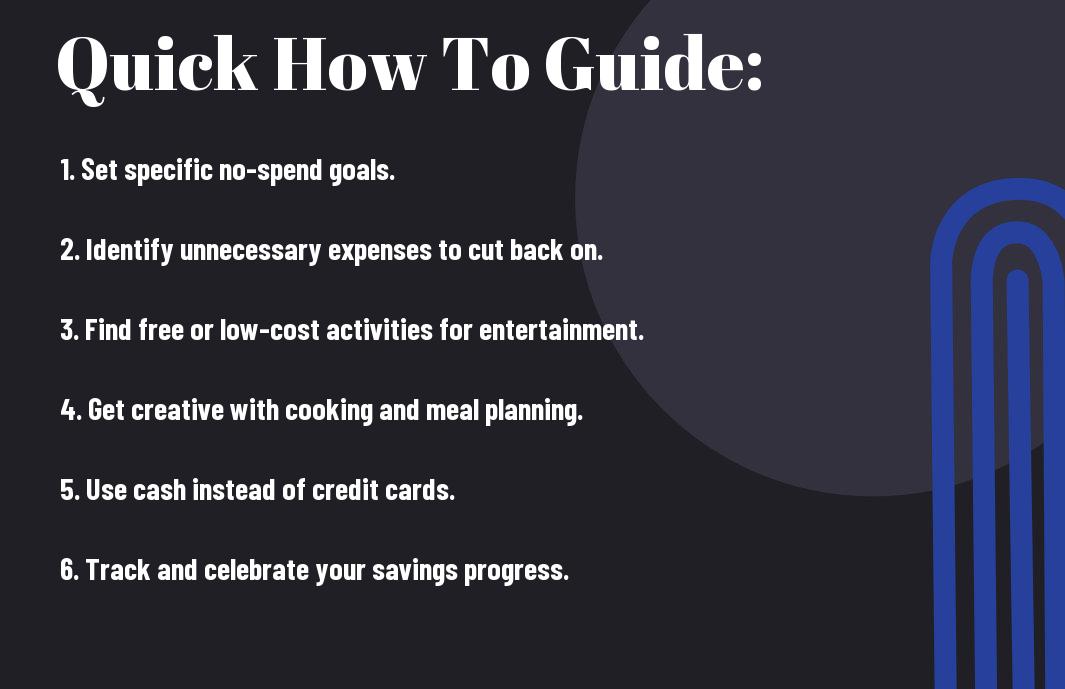Resetting your financial habits can be a transformative experience that leads to increased savings and a greater sense of control over your finances. One popular method for achieving this reset is through no-spend challenges, where participants commit to avoiding unnecessary expenses for a set period of time. By taking on this challenge, individuals can break free from the cycle of mindless spending and develop a more mindful approach to managing their money.
In this blog post, we will explore the benefits of no-spend challenges and provide actionable tips on how to successfully complete one. From identifying your spending triggers to finding creative ways to enjoy free or low-cost activities, we will guide you through the process of resetting your financial habits and boosting your savings. Whether you’re looking to kickstart your journey towards financial freedom or simply want to cultivate a healthier relationship with money, begining on a no-spend challenge could be the perfect starting point.
The Psychology Behind Spending
The Gratification Trap
To understand the allure of spending, we must first acknowledge the gratification trap that many of us fall into. It’s easy to get caught up in the momentary pleasure of purchasing something new, whether it’s a trendy outfit or the latest gadget. However, this instant gratification often leads to impulse buying and overspending, ultimately hindering our ability to save money for more important financial goals. To break free from this cycle, we need to shift our mindset and prioritize long-term financial health over short-term indulgence.
Rewiring Your Financial Mindset
Behind every spending decision lies a complex web of emotions, habits, and beliefs that influence our relationship with money. By taking intentional steps to rewire our financial mindset, we can gain better control over our spending habits and make more conscious choices about how we allocate our resources. This process requires self-awareness, discipline, and a willingness to challenge our ingrained beliefs about money and consumption.
Plus, research shows that practicing no-spend challenges can have a profound impact on our financial well-being. According to a study by the University of Chicago, participants who completed a no-spend challenge reported increased feelings of empowerment and control over their finances, leading to greater savings and reduced debt. By embracing the psychology behind spending and actively reshaping our financial habits, we can set ourselves on a path to long-term financial success and stability.

Preparing for a No-Spend Challenge
Even though begining on a no-spend challenge may seem daunting at first, the benefits far outweigh the initial trepidation. By taking the time to prepare for the challenge, you set yourself up for success and the potential to reset your financial habits for the better.
Setting Clear Goals and Parameters
To make the most out of a no-spend challenge, it is necessary to establish clear goals and parameters from the start. Determine the duration of the challenge, the specific rules you will follow, and what you hope to achieve by the end of it. Whether your aim is to boost savings, pay off debt, or simply become more mindful of your spending habits, having a clear roadmap in place will keep you focused and motivated throughout the challenge.
How to Identify Needs vs. Wants
Challenge yourself to distinguish between your needs and wants as you prepare for a no-spend challenge. While needs are necessary for survival and well-being, wants are often discretionary expenses that can be minimized or eliminated. Take a close look at your spending patterns and identify areas where you can cut back on non-necessary purchases. By differentiating between needs and wants, you can prioritize your spending towards what truly matters and avoid unnecessary expenses that can derail your financial goals.
Practical Tips for a Successful No-Spend Challenge
Not sure where to start when commenceing on a no-spend challenge? Follow these practical tips to set yourself up for success:
- Set specific goals for your no-spend challenge to keep yourself motivated and focused.
- Track your spending and savings throughout the challenge to see tangible results.
- Find support from friends or online communities to stay accountable and share tips and tricks.
Any financial decisions or purchases during the no-spend challenge should be carefully considered to ensure they align with your goals.
How to Track Your Spending and Savings
NoSpend month challenges can be made more effective by tracking your spending and savings diligently. Utilize tools like budgeting apps or spreadsheets to monitor your expenses and see where you can cut back. Check out this inspiring story on I Saved $1000 in a No-Spend Month Challenge for more motivation.
Curbing Impulse Purchases
Successful completion of a no-spend challenge often hinges on curbing impulse purchases. By identifying triggers that lead to unnecessary spending and implementing strategies such as shopping lists and waiting periods before making a purchase, you can avoid impulse buys and stay on track with your savings goals.
Recall, every dollar saved during a no-spend challenge brings you closer to financial freedom and security. Stay disciplined, stay focused, and watch your savings grow.

Creating a Sustainable Budget Post-Challenge
Many people find that participating in no-spend challenges like the popular “No-Spend January” can be a powerful way to reset their financial habits and boost savings. As you wrap up your challenge and transition back to regular spending, it’s important to take a closer look at your budget. Reflect on the lessons learned during the challenge and identify areas where you can make lasting changes to create a more sustainable budget moving forward. For tips on how to make the most out of your no-spend experience, check out this insightful article on How to make no-spend January work for you.
Analyzing Spending Habits Post-Challenge
Creating a post-challenge budget involves analyzing your spending habits post-challenge. Look closely at your expenses during the no-spend period and compare them to your typical spending patterns. Identify any unnecessary expenses that you were able to cut out during the challenge and consider how you can continue to reduce those expenses moving forward. Use this reflection as a foundation for building a sustainable budget that aligns with your financial goals and priorities.
How to Allocate Savings Effectively
An effective way to allocate savings post-challenge is to divide your savings into different buckets based on your financial goals. Consider establishing separate savings accounts for emergency funds, retirement savings, and other long-term goals. By allocating your savings strategically, you can ensure that you are making progress towards multiple financial objectives simultaneously. Keep in mind that consistency is key when it comes to saving money, so aim to automate your savings contributions to stay on track with your goals.

Overcoming Obstacles During No-Spend Challenges
Once again, commenceing on a no-spend challenge can be a transformative experience, but there will inevitably be obstacles along the way. Learning how to navigate these challenges can make all the difference in achieving your financial goals.
How to Deal with Social Pressures
Dealing with social pressures during a no-spend challenge requires careful planning and open communication. Recognize that not everyone in your circle may understand or support your goals, but that doesn’t diminish the importance of staying true to your commitment. Be honest about your financial goals and boundaries with friends and family, and seek out alternatives to social gatherings that may tempt you to overspend. Remember that your financial well-being is a top priority and that setting healthy boundaries is necessary for reaching your goals.
Strategies for Handling Unexpected Expenses
Assuming that unexpected expenses will arise during your no-spend challenge, it’s crucial to have a plan in place for how to handle them without derailing your progress. Consider building an emergency fund to cover unforeseen costs, or exploring creative solutions such as selling items you no longer need or taking on additional freelance work. By being prepared and proactive, you can navigate any financial curveballs that come your way during a savings challenge.
Social pressures and unexpected expenses are common obstacles that may arise during a no-spend challenge, but with the right strategies in place, they can be overcome. Stay focused on your goal, be flexible in your approach, and remember that temporary sacrifices can lead to long-term financial success.
Long-Term Benefits of No-Spend Challenges
All financial health journeys have their ups and downs, but the long-term benefits of no-spend challenges are well worth the effort. By participating in these challenges, individuals can reset their financial habits and boost their savings in significant ways.
Factors Contributing to Continued Financial Health
Clearly, adopting a no-spend challenge helps individuals become more intentional with their spending and fosters a sense of discipline when it comes to financial decision-making. This newfound mindfulness can lead to long-lasting changes in behavior and create a solid foundation for financial stability moving forward. During a no-spend challenge, participants usually reassess their needs versus wants, prioritize savings, and practice delayed gratification, all of which are crucial factors contributing to continued financial health.
- Assume that by continuing to prioritize savings and practice mindful spending habits, individuals can achieve financial goals more efficiently.
- Assume that no-spend challenges can instill a sense of empowerment and control over one’s finances, leading to long-lasting positive impacts.
Building Better Spending Habits for Life
Now, let’s research into how participating in no-spend challenges can help in building better spending habits for life. Through these challenges, individuals not only learn to differentiate between necessary and non-necessary expenses but also develop the necessary skills to curb impulse purchases, resist lifestyle inflation, and cultivate a more sustainable approach to managing their finances.
Life after a no-spend challenge often involves individuals making smarter financial decisions, taking advantage of opportunities to increase their wealth, and overall, feeling more confident and in control of their financial futures. By committing to regular financial check-ins and maintaining the discipline learned during the challenge, individuals can create a solid financial foundation that can last a lifetime.

To wrap up
Ultimately, participating in no-spend challenges can be a powerful tool to reset your financial habits and boost your savings. By taking a break from unnecessary spending, you can reassess your priorities, become more mindful of your purchasing decisions, and cultivate a healthier relationship with money. The sense of accomplishment that comes with successfully completing a no-spend challenge can also provide a significant motivation to continue making positive changes in your financial life.
Remember to set clear goals, create a realistic budget, and seek support from friends or online communities during your no-spend challenge. With dedication and perseverance, you can not only save money but also gain a greater sense of control and empowerment over your finances. So why not give it a try and initiate on your own no-spend challenge today?
FAQ
Q: What is a no-spend challenge?
A: A no-spend challenge is a period of time where you commit to not spending money on non-necessary items, such as dining out, shopping, or unnecessary services, to reset your financial habits and boost your savings.
Q: What are the benefits of participating in a no-spend challenge?
A: Participating in a no-spend challenge can help you become more mindful of your spending habits, break the cycle of impulse buying, save money for future goals, and create a healthier relationship with money.
Q: How long should a no-spend challenge typically last?
A: No-spend challenges can vary in length depending on your goals and comfort level. They can range from a weekend challenge to a month-long challenge, but the key is to set a realistic timeframe that challenges you without being overwhelming.
Q: What are some tips for succeeding in a no-spend challenge?
A: To succeed in a no-spend challenge, it’s important to set clear goals, create a budget, track your expenses, avoid temptation by unsubscribing from marketing emails and unfollowing shopping websites on social media, and find free or low-cost activities to replace spending.
How can a no-spend challenge help reset financial habits and boost savings?
A: By participating in a no-spend challenge, you can identify areas of unnecessary spending, prioritize your needs over wants, learn to distinguish between necessary and non-necessary expenses, build discipline in managing your finances, and ultimately increase your savings for emergencies or long-term financial goals.



